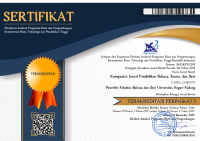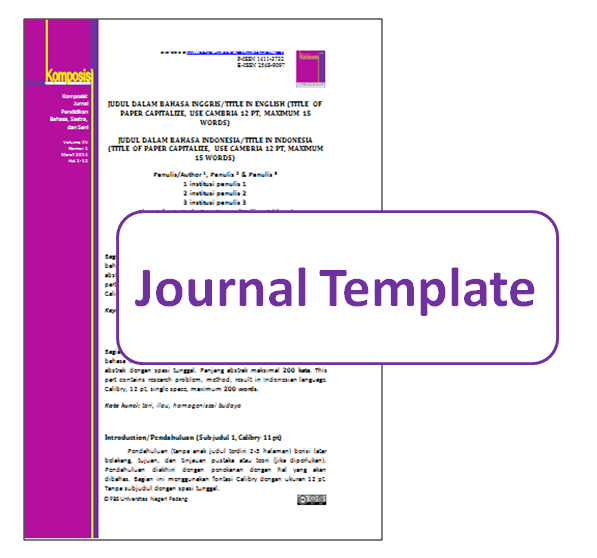Between Multicultural Students, Speech Act, and Politeness
Munawwir Hadiwijaya, Maya Rizki Amalyasari
Abstract
This study aims to reveal the use of directive speech acts of multicultural students studying in Malang City in the context of politeness. Qualitative descriptive is the method used in this study. There are five tribes that are the subject of this research, namely Java, Sumba, Flores, Dayak, and Madura. Data were collected by using questionnaires, interviews, and observations. The data obtained were analysed based on how they used directive request speech act in different situations in the domain of family, friendship, and school and how they minimized the FTA that might occurs when facing different speech partners. The results of this study indicate that from the four aspects that become the parameters of this study, multicultural students in using directive speech acts have the following pattern: In the aspect of direct / indirect speech acts, in three different domains, all multicultural students use direct speech acts, as well as in the honorific aspect. The use of hedge aspects is more widely used in the campus domain. Meanwhile, in the aspect of speech level, only Javanese and Madurese students use it.
Keywords
directive speech acts; politeness; multicultural students
References
Ariyanti, L.D. & Zulaeha, I. (2017). Tindak Tutur Ekspresif Humanis dalam Interaksi Pembelajarandi SMA Negeri 1 Batang: Analisis Wacana Kelas. SELOKA, 6 (2), 111-122.
Asmorotedjo, A. (2019). BALI JAWI: Menghidupkan Kembali Nilai-Nilai Luhur Manusia Jawa. JOGED, 13 (1), 1-15.
Barron, A. (2017). The speech act of ‘offers’ in Irish English. World Englishes, 36 (2), 224-238.
Fajariyah, L. (2020). The social stratification of the Madurese society and its implications on the usage of Bhasa Madhura. Simulacra, 3(2), 165–178
Grice, H.P. (1991). Studies in the Way of Words. Harvard University Press.
Hadiwijaya, M., & Yahmun, Y. (2017). Kesantunan Berbahasa dalam Iinteraksi Antara Dosen dan Mahasiswa Multikultural. DIDAKTIKA: Jurnal Pemikiran Pendidikan, 23(2), 142-154.
Kroeger, P. R. (2018). Analyzing Meaning: An Introduction to Semantics and Pragmatics. Language Science Press.
Liliweri, A., (2005). Prasangka dan Konflik; Komunikasi Lintas Budaya Masyarakat Multikultur. LKIS PELANGI AKSARA.
Nagaya, N. (2012) "The Lamaholot Language of Eastern Indonesia." Diss., Rice University. https://hdl.handle.net/1911/70366.
Purwadi, S. (2013). Marapu: Konstruksi Identitas Budaya Orang Sumba, NTT. ANTROPOLOGI INDONESIA, 34(1), 59-73.
Subroto, D.E., Dwiraharjo, M. & Setiawan, B. (2008). Buku Pedoman: Pemakaian Tingkat Tutur Ngoko dan Krama dalam Bahasa Jawa. Surakarta: PPs S3 UNS.
Suryadi, M., Subroto, D.E., & Marmanto, S. (2014). The Use of Krama Inggil (Javanese Language) in Family Domain at Semarang and Pekalongan Cities. International Journal of Linguistics, 6 (3), 243-256.
Wardhaugh, R. (2006). An Introduction to Sociolinguistics Fifth Edition. Oxford: Blackwell Publishing Ltd.
Yulianti, I.A. (2015). CAMPUR KODE BAHASA DAYAK NGAJU DAN BAHASA INDONESIA PADA KICAUAN TWITTER REMAJA DI PALANGKARAYA (Code Mixing of Dayak Ngaju and Indonesian Language on Twitter Among Teenageers in Palangkaraya). KANDAI, 11(1), 15-28
Yule, G. (1996). Pragmatics. Oxford University Press.
DOI:
https://doi.org/10.24036/komposisi.v23i1.113130
Refbacks
There are currently no refbacks.
Copyright (c) 2022 Komposisi: Jurnal Pendidikan Bahasa, Sastra, dan Seni
This work is licensed under a
Creative Commons Attribution-NonCommercial 4.0 International License .
Komposisi: Jurnal Pendidikan Bahasa, Sastra, dan Seni , a peer-reviewed online journal in languages, literature, and arts education.
Printed ISSN 1411-3732 , Online ISSN 2548-9097 .
Currently, Komposisi: Jurnal Pendidikan Bahasa, Sastra, dan Seni is indexed by: View My Stats
Visitors since February 2017:
Statcounter <div class="statcounter"><a title="web analytics" href="http://statcounter.com/" target="_blank"><img class="statcounter" src="//c.statcounter.com/11239717/0/d5796c6b/0/" alt="web analytics"></a></div> View My Stats
Published by:
Universitas Negeri Padang (UNP) Address: Faculty of Languages and Arts (FBS) Universitas Negeri Padang. Jl Prof. Dr. Hamka Air Tawar Barat, Padang - West Sumatera -Indonesia Telp/Fax. +62751 7053363 Home page: http://ejournal.unp.ac.id/index.php/komposisi | e-mail:komposisi.fbsunp @ fbs.unp.ac.id | cc: havid_a @ fbs.unp.ac.id
Server Luar
slot88
King Wood Car Care slot gacor
scam
situs toto
bandar togel
bandar togel
Slot Gacor Hari ini
situs toto
situs toto
toto togel
togel online
topup murah
harapan777
AMDBET
toto togel
slot88
login bayar4d
macau303
slot resmi apk slot online Slot Maxwin
situs toto
sakti55
situs toto felix168
nextogel
NEXTOGEL
NEXTOGEL
NEXTOGEL
NEXTOGEL
NEXTOGEL
NEXTOGEL
NEXTOGEL
NEXTOGEL
NEXTOGEL
NEXTOGEL
NEXTOGEL
NEXTOGEL
NEXTOGEL
NEXTOGEL
NEXTOGEL
NEXTOGEL
NEXTOGEL
NEXTOGEL
NEXTOGEL
NEXTOGEL
NEXTOGEL
NEXTOGEL
NEXTOGEL
NEXTOGEL
NEXTOGEL
NEXTOGEL
NEXTOGEL
NEXTOGEL
NEXTOGEL
NEXTOGEL
NEXTOGEL
JEPETOGEL
JEPETOGEL
JEPETOGEL
JEPETOGEL
KIM369
KIM369
KIM369
KIM369
KIM369
KIM369
KIM369
KIM369
KIM369
KIM369
situs toto toto slot kuntogel
situs toto toto slot sendok88
togel online toto slot https://www.eaglehighplantations.id/
toto macau
slot gacor slot gacor
batak5d toto slot Slot88 www.onscripture.com
slot online
situs toto
situs gacor bandar togel resmi toto togel https://montreallawfirm.com
wild west gold sering pecah
Toto 4D
slot88
toto macau
Situs Toto
Situs Toto
https://mercubuana.org/
Toto 4d
toto 4d
Toto 4D
toto 4d
info rtp akurat malam ini
Wanita Subang Beli mobil dari Nolimit city
rahasia Cuan Aztech Gems
Gatot kaca Buat TKW Jadi jutawan
Rahasia sukses bermain Mahjing wins
harapan princess starlight
Harapan sweet bonanza
taktik gates of olympus xmas
dukungan gates olympus
rahasia sukses bermain mahjong ways
Situs togel
slot gacor 2025
luxury89
Sulebet
sulebet
oja89
basic4d
situs toto togel online
vipbet888
momo128 login
https://garudafood.org/
jpmania mesin128
mesin128
mesin128
oja89
slot gacor
jumat4d slot login
https://pintu-pro.id/
slot gacor
Buat yang suka cari link slot gacor hoki69 maxwin tiap hari, ini tempat yang paling sering gue datengin.
choicehomecontractors.com
sarangslot
slot 4d gacor hari ini
Toto 4D
https://up2m.pkr.ac.id/jepangbet/
slot
simpatitogel
slot gacor hari ini
slot gacor
slot
https://unesa.id/












